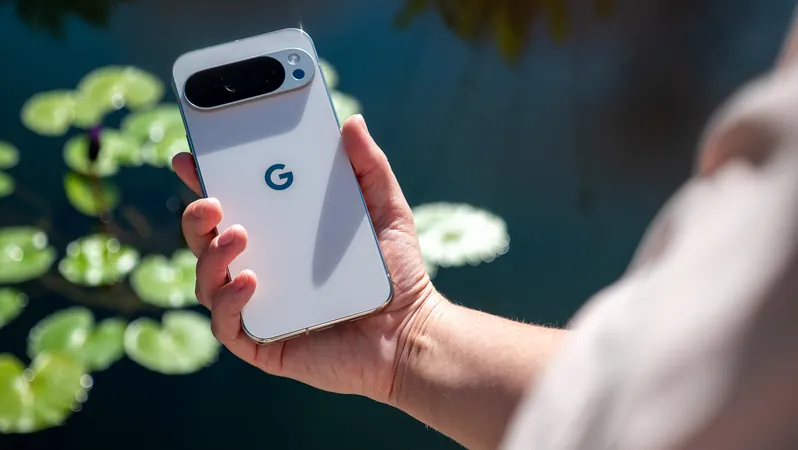
Google Pixel 10 Pro XL vs. OnePlus 13: Clash of the Android Titans!
2025-09-08
Author: Jacques
The highly anticipated Google Pixel 10 Pro XL has arrived, and while it may not have a completely new look compared to its predecessor, the Pixel 9 Pro XL, it's brimming with impressive upgrades. As Google’s largest and priciest flagship for 2025, it’s set to compete fiercely with the equally impressive OnePlus 13.
The OnePlus 13 is turning heads with its cutting-edge specs, including a superior chipset, a brilliant AMOLED display, and a larger battery with super-fast charging capabilities. Although the Pixel 10 Pro XL costs a bit more, their price ranges are similar, making for an exciting showdown between these two colossal smartphones.
Pricing and Availability: What You Need to Know
Unveiled at the Made by Google event on August 20, 2025, the Pixel 10 Pro XL starts at a cool $1,199 for the base model featuring 16GB RAM and 256GB of storage. Buyers can opt for larger storage versions at 512GB and 1TB for an additional cost. It comes in four stunning colorways: Moonstone, Jade, Porcelain, and Obsidian.
In contrast, the OnePlus 13 offers a more wallet-friendly entry point starting at $900, featuring 12GB RAM and 256GB storage. For just $100 more, you can double the storage with a 512GB model that includes 16GB RAM. The base version is available in the sleek Black Eclipse, while the higher-end variant flaunts three attractive finishes.
Design and Display: Style Meets Functionality
The Pixel 10 Pro XL and OnePlus 13 embody two distinct design philosophies. The Pixel boasts a refined look with flat edges and a signature pill-shaped visor that houses all the camera sensors. It also sports a bolder "G" logo front and center.
Meanwhile, the OnePlus 13 features a modern circular camera module and a seamless curved display that melds into its frame, offering a more ergonomic grip. The OnePlus 13's dimensions are a bit larger with a 6.82-inch display, compared to the Pixel 10 Pro XL’s slightly smaller 6.8-inch screen.
Although the Pixel is a tad heftier at 232 grams, it compensates with a unique advantage—built-in magnets for MagSafe-like Qi2 wireless charging, eliminating the need for third-party accessories. This flagship also boasts the highest Qi2.2 standard for wireless charging, outperforming the OnePlus 13’s wireless capabilities.
Hardware and Performance: Under the Hood
Powering the Pixel 10 Pro XL is Google's cutting-edge Tensor G5 chipset, crafted to deliver remarkable AI performance and sustained efficiency. This marks a significant step up from previous models, positioning it favorably against the competition.
On the flip side, the OnePlus 13 runs on Qualcomm's Snapdragon 8 Elite, widely regarded as the best chipset for Android devices. While Google's Tensor G5 introduces impressive advancements, it doesn't quite match the benchmarks achieved by the Snapdragon.
In terms of battery and charging tech, the OnePlus 13 stands out with a robust 6,000 mAh battery and blistering 100W SuperVOOC fast charging. The Pixel's 5,200 mAh battery and 45W charging may lag behind in raw power, but it compensates with superior wireless charging features.
Camera Capabilities: Snap and Capture!
When it comes to cameras, both flagships are equipped with capable triple-camera systems. The Pixel excels with its 50MP primary sensor paired with impressive zoom capabilities, thanks to AI-enhanced Pro Res Zoom, allowing for up to 100x zoom.
The OnePlus 13 features a robust 50MP camera set as well, but it takes an edge in digital zoom, reaching 120x. With Hasselblad’s color tuning, OnePlus delivers bright and vivid shots, although there are hints its partnership might evolve in future models.
Conclusion: Which One Wins?
Deciding between the Google Pixel 10 Pro XL and OnePlus 13 boils down to your personal preferences and requirements. The Pixel may not lead in benchmark performance, but it provides a seamless user experience enriched with AI features and extended software support.
Whether you value superior photography, build quality, or software longevity, both devices bring powerful options to the table. Whichever you choose, rest assured you’re investing in a top-tier Android experience!









 Brasil (PT)
Brasil (PT)
 Canada (EN)
Canada (EN)
 Chile (ES)
Chile (ES)
 Česko (CS)
Česko (CS)
 대한민국 (KO)
대한민국 (KO)
 España (ES)
España (ES)
 France (FR)
France (FR)
 Hong Kong (EN)
Hong Kong (EN)
 Italia (IT)
Italia (IT)
 日本 (JA)
日本 (JA)
 Magyarország (HU)
Magyarország (HU)
 Norge (NO)
Norge (NO)
 Polska (PL)
Polska (PL)
 Schweiz (DE)
Schweiz (DE)
 Singapore (EN)
Singapore (EN)
 Sverige (SV)
Sverige (SV)
 Suomi (FI)
Suomi (FI)
 Türkiye (TR)
Türkiye (TR)
 الإمارات العربية المتحدة (AR)
الإمارات العربية المتحدة (AR)